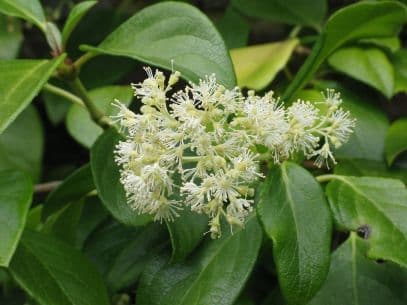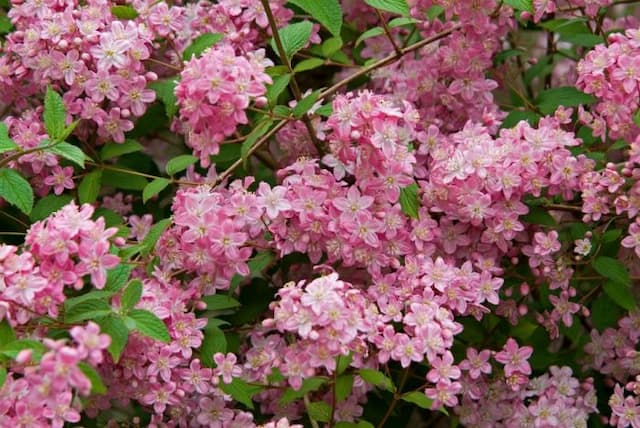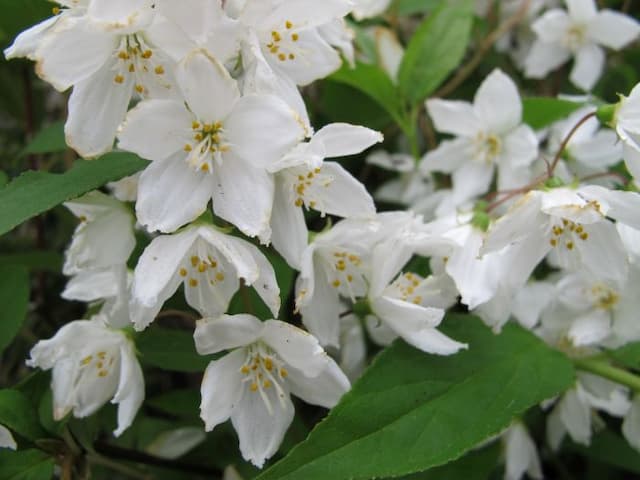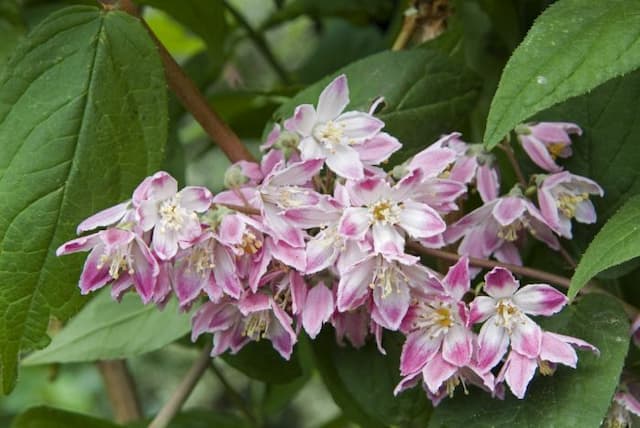Hydrangea Hydrangea macrophylla Magical Revolution = 'Hokomarevo' (PBR) (Magical Series) (H)
![hydrangea [Magical Revolution]](/_next/image?url=https%3A%2F%2Fplants-admin.emdemapps.com%2Fimages%2Fplants%2F%2Fimages%2F604b560c46abf.png&w=3840&q=75)
ABOUT
The Hydrangea macrophylla Magical Revolution, part of the Magical Series, is a lovely flowering shrub known for its enchanting blooms and lush foliage. It boasts rounded flower clusters, which are notable for their ability to change color over the course of the blooming period. These flowers typically emerge in various shades, that can include pinks, blues, and purples, depending on soil acidity. As the blooms mature, they take on deeper and richer tones, adding to the plant's magical appeal. The flowers present a captivating display that evolves through the seasons, often edged with a contrasting color that accentuates their beautiful spherical shape. The leaves of this variety are substantial, glossy, and dark green, providing a striking backdrop to the magnificent blooms. The foliage contributes to the overall lush appearance of the plant, giving it a robust and healthy look. These broad leaves often have serrated edges, and they cluster around sturdy stems that help support the weight of the heavy flowers. This hydrangea’s strong presence is complemented by its dense, bushy growth habit, which creates a rounded silhouette. The shrub is valued not just for its floriferous nature but also for the texture and volume it adds to gardens. Its leaves and flowers together make it a focal point wherever it is planted, garnering attention throughout its blooming season. The Magical Revolution hydrangea is a favorite among gardeners and landscapers for its enchanting floral display and its ability to bring a touch of magic to any outdoor space.
About this plant
 Names
NamesFamily
Hydrangeaceae.
Synonyms
French Hydrangea, Bigleaf Hydrangea, Mophead Hydrangea, Lacecap Hydrangea, Hortensia.
Common names
Hydrangea macrophylla 'Hokomarevo'
 Toxicity
ToxicityTo humans
Hydrangeas, including the Hydrangea macrophylla or commonly known as bigleaf hydrangea, can be toxic if ingested due to the presence of cyanogenic glycosides found primarily in the leaves and flower buds. If parts of the plant are consumed in large quantities, it might lead to symptoms like stomach upset, nausea, vomiting, and sweating. In severe cases or rare circumstances, more serious symptoms such as dizziness and confusion could occur due to cyanide release in the body. Keep in mind that poisoning from hydrangeas is uncommon and generally occurs only from ingestion of large quantities of plant material.
To pets
Hydrangeas, including the Hydrangea macrophylla or commonly known as bigleaf hydrangea, are also toxic to pets, including cats and dogs, due to the same cyanogenic glycosides. If pets ingest parts of this plant, they may experience symptoms such as vomiting, diarrhea, and lethargy. In more severe cases or if a large amount is consumed, poisoning might lead to depression, confusion, and increased heart rate. It's important to keep pets away from hydrangeas and to contact a veterinarian if there are signs that the pet has ingested parts of the plant.
 Characteristics
CharacteristicsLife cycle
Perennials
Foliage type
Deciduous
Color of leaves
Varies
Flower color
Varies
Height
3-4 feet [0.91-1.22 meters]
Spread
3-4 feet [0.91-1.22 meters]
Plant type
Shrub
Hardiness zones
5
Native area
Japan
Benefits
 General Benefits
General Benefits- Attractive Flowers: Hydrangea macrophylla 'Magical Revolution' boasts large, colorful blooms which can range from pink to blue depending on soil pH, adding visual interest to gardens.
- Long Blooming Season: This variety has a long flowering period from early summer to late fall, providing extended garden beauty.
- Versatility in Landscaping: Suitable for a variety of garden styles, including borders, containers, and as a specimen plant.
- Seasonal Change: The flowers of Hydrangea macrophylla 'Magical Revolution' often change color as they age, transitioning through several hues, which adds a dynamic element to the plant's display.
- Easy to Grow: Generally easy to care for, needing only basic watering and fertilizing to thrive, and is reasonably hardy in appropriate climates.
- Attracts Pollinators: The flowers can attract butterflies and other pollinators, which are beneficial for the garden ecosystem.
- Pruning Flexibility: Pruning is not essential but can be done to maintain shape and size or to encourage more prolific blooming.
- Good Cut Flowers: The blooms are long-lasting when cut and make excellent arrangements for indoor decoration.
 Medical Properties
Medical PropertiesThis plant is not used for medical purposes.
 Air-purifying Qualities
Air-purifying QualitiesThis plant is not specifically known for air purifying qualities.
 Other Uses
Other Uses- Crafting Dried Flower Arrangements: The colorful blooms of the hydrangea can be dried and used in floral displays that maintain their beauty for a long time.
- Pressed Flower Art: The individual petals of hydrangeas can be pressed and used in creating intricate and beautiful artwork on paper or in frames.
- Natural Dyes: Hydrangeas can be used to produce natural dyes for fabrics or paper, with different pH levels in the soil affecting the color outcome of the dye.
- Photography Subject: Due to its vibrant and large flower heads, the hydrangeas serve as an excellent subject for botanical photography and garden portfolio pieces.
- Garden Weddings: Hydrangeas are often used as natural decor for garden weddings, with their lush bloom clusters adding elegance to the venue.
- Culinary Garnish: Although not edible, hydrangea blooms can be used as a temporary ornamental garnish for plating in high-end culinary presentations.
- Bookmarks: Dried hydrangea petals can be laminated and used as decorative bookmarks, combining a love for gardens with reading.
- Tea Ceremony Decoration: In some cultures, hydrangea blooms are used as part of the decor for traditional tea ceremonies, adding a touch of natural beauty.
- Feng Shui: In certain practices of Feng Shui, hydrangeas are placed in areas to create a calming and harmonious environment.
- Art Classes: Hydrangea flowers can be used to teach botanical illustration and watercolor techniques in art classes, as they offer a range of colors and complex shapes to challenge artists.
Interesting Facts
 Feng Shui
Feng ShuiThe Hydrangea is not used in Feng Shui practice.
 Zodiac Sign Compitability
Zodiac Sign CompitabilityThe Hydrangea is not used in astrology practice.
 Plant Symbolism
Plant Symbolism- Understanding: Hydrangeas are often associated with comprehension and enlightenment due to their lush, multifaceted blooms that could represent layers of knowledge and depth of insight.
- Heartfelt and Sincere Emotions: With their full, round shape, hydrangeas can symbolize the fullness of emotion. They might be given to express genuine, heartfelt sentiments.
- Gratitude: A common meaning tied to the hydrangea is gratitude for being understood, making these flowers a popular gift to express appreciativeness and thankfulness.
- Apology: In some contexts, hydrangeas have been given as a symbol of apology or penitence, perhaps because of their ample shape, which can signify an overflowing sense of remorsefulness.
- Vanity or Boastfulness: In some cultures, the hydrangea can represent vanity or boastfulness due to their showy appearance and the abundance of flowers on each head.
- Abundance and Prosperity: The lush, abundant blooms of the hydrangea can symbolize prosperity and abundance, much like a full and fruitful life or relationship.
- Perseverance: Hydrangeas can grow in a variety of conditions and can represent steadfastness or the ability to persist in the face of adversity.
 Water
WaterTo ensure proper hydration for your Hydrangea macrophylla, commonly known as hortensia, water the plant deeply once or twice a week, providing about 1 to 1.5 gallons each time depending on weather conditions. During periods of drought or extreme heat, you may need to water more frequently. It's important to avoid overhead watering to keep the flowers and leaves dry, reducing the risk of fungal diseases. Rather, apply water directly to the base of the plant, soaking the soil to a depth of about 6 inches. Always check the soil moisture before watering; the soil should be moist but not soggy.
 Light
LightHortensias thrive best in partial shade with some morning sunlight and afternoon protection from the intense sun. The ideal spot for these plants is one where they receive dappled sunlight throughout the day or direct sunlight only during the cooler parts of the day. Avoid placing them in deep shade or full afternoon sun, which can lead to poor flowering and leaf scorch.
 Temperature
TemperatureHortensias prefer moderate temperatures and can generally survive in a range between 50°F and 86°F. The ideal temperature for promoting growth and flowering is between 65°F and 75°F. They can tolerate brief periods of colder weather down to about 32°F, but prolonged exposure to freezing temperatures can damage the plant.
 Pruning
PruningPrune hortensias after they have finished blooming, typically late winter or early spring, to remove dead wood and shape the plant. Because they bloom on old wood, avoid heavy pruning or cutting back the stems too severely, as this can reduce flowering. Pruning annually helps encourage healthy growth and abundant blooms for the following season.
 Cleaning
CleaningAs needed
 Soil
SoilHydrangeas require well-draining, rich, and loamy soil with a pH of 5.5 to 6.5 for optimal growth. A mixture of garden soil, compost, and peat moss in equal parts can create an ideal growing medium. The soil's acidity affects flower color, with a lower pH producing blue flowers and a higher pH resulting in pink flowers.
 Repotting
RepottingHydrangeas should be repotted every 2-3 years to replenish their soil and give them room for root growth. The best time to repot is in late winter or early spring before new growth begins.
 Humidity & Misting
Humidity & MistingHydrangeas thrive in moderate to high humidity levels. The ideal range is approximately 50-70%, ensuring enough moisture in the air to support their large leaves and lush growth.
 Suitable locations
Suitable locationsIndoor
Give hydrangeas bright, indirect light and keep soil moist.
Outdoor
Plant in morning sun, afternoon shade, keep soil moist.
Hardiness zone
5-9 USDA
 Life cycle
Life cycleHydrangea macrophylla, commonly known as bigleaf hydrangea, begins its life cycle with seed germination in favorable conditions of warmth and moisture. The seedling establishes itself and gradually develops into a young plant with characteristic large leaves and woody stems. Over time, the hydrangea enters a maturation phase where it begins to produce large, showy flower heads that can be pink, blue, or purple, depending on the soil pH. After the flowering period, which typically occurs in summer, the plant sets seed, and the flowers fade. Throughout fall and winter, the hydrangea enters dormancy, with its above-ground parts dying back in colder climates, to re-emerge from its root system or dormant buds in spring. This cyclical process repeats annually, with the plant potentially living and flowering for many years if given proper care and environmental conditions.
 Propogation
PropogationPropogation time
Spring to Summer
The most popular method of propagating Hydrangea macrophylla, commonly known as Bigleaf Hydrangea, particularly the 'Magical Revolution' variety, is through stem cuttings. This is typically done in late spring to early summer. A cutting of about 5 to 6 inches (approximately 12 to 15 centimeters) with several pairs of leaves is taken from a healthy parent plant. The lower leaves are removed and the cut end of the stem is dipped in rooting hormone. The cutting is then planted in moist potting soil, and a plastic bag or a propagator can be used to maintain humidity. It is important to keep the soil moist but not soggy and to place the cutting in bright, indirect light until roots have developed, which may take several weeks. Once rooted, the new hydrangea plant can be gradually acclimated to its new environment and eventually transplanted outdoors.






![Rose deutzia [Yuki Cherry Blossom]](/_next/image?url=https%3A%2F%2Fplants-admin.emdemapps.com%2Fimages%2Fplants%2F%2Fimages%2F604b6510a383a.png&w=640&q=75)

![Hydrangea [Hot Chocolate]](/_next/image?url=https%3A%2F%2Fplants-admin.emdemapps.com%2Fimages%2Fplants%2F%2Fimages%2F604b5a066e3bd.png&w=640&q=75)
![Hydrangea [Blackberry Pie]](/_next/image?url=https%3A%2F%2Fplants-admin.emdemapps.com%2Fimages%2Fplants%2F%2Fimages%2F604b56e2abc1d.png&w=640&q=75)